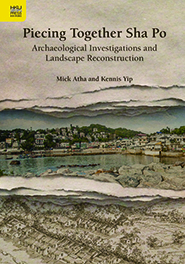Piecing Together Sha Po: Archaeological Investigations and Landscape Reconstruction
|
Speakers: |
Mick Atha (Archaeologist & Adjunct Assistant Professor, |
|
Moderator: |
Mr Hing-Wah Chau (Curator, Intangible Cultural Heritage Office) |
|
Date: |
9 February 2017 (Thursday) |
|
Time: |
6:30 - 8:00 pm |
|
Venue: |
Special Collections, 1/F, Main Library, The University of Hong Kong |
|
Language: |
English |
Click here to re-visit the book talk Piecing Together Sha Po
About the Speakers
|
|
Mick Atha is a UK-trained archaeologist, university lecturer, and editor who has been based in Hong Kong for over nine years. Since 2011 he has taught in the Department of Anthropology at the Chinese University of Hong Kong, delivering courses on Hong Kong archaeology, archaeological field methods, and landscape studies. Kennis Yip studied field archaeology in the UK and has worked for an archaeological consultancy firm in Hong Kong since 1999. As well as working together on the Sha Po research, Mick and Kennis have also collaborated on various archaeological research projects such as the geophysical survey and excavation of a Tang dynasty cemetery at San Tau on Lantau Island and, most recently, the survey and excavation of a Han dynasty coastal settlement on Yim Tin Tsai Island near Sai Kung. They are married with a daughter and live near Sha Po on Lamma Island. |
About the Book
|
|
Hong Kong boasts a number of rich archaeological sites behind sandy bays. Among these backbeaches is Sha Po on Lamma Island, a site which has long captured the attention of archaeologists. However, until now no comprehensive study of the area has ever been published. Piecing Together Sha Po presents the first sustained analysis, framed in terms of a multi-period social landscape, of the varieties of human activity in Sha Po spanning more than 6,000 years. Synthesising decades of earlier fieldwork together with Atha and Yip’s own extensive excavations conducted in 2008–2010, the discoveries collectively enabled the authors to reconstruct the society in Sha Po in different historical periods. The artefacts unearthed from the site—some of them unique to the region—reveal a vibrant past which saw the inhabitants of Sha Po interacting with the environment in diverse ways. Evidence showing the mastery of quartz ornament manufacture and metallurgy in the Bronze Age suggests increasing craft specialisation and the rise of a more complex, competitive society. Later on, during the Six Dynasties–Tang period, Sha Po turned into a centre in the region’s imperially controlled kiln-based salt industry. Closer to our time, in the nineteenth century the farming and fishing communities in Sha Po became important suppliers of food and fuel to urban Hong Kong. Ultimately, this ground-breaking work tells a compelling story about human beings’ ceaseless reinvention of their lives through the lens of one special archaeological site. |
About the Moderator
|
|
Mr Chau Hing-wah received his Bachelor of the Arts from the University of Hong Kong in 1983 and his Master of Arts in Archaeology from the Institute of Archaeology, University College London in 1988. He joined the curatorial grade of the Hong Kong Government in 1985 and has been working for many years in the field of archaeology and conservation of cultural heritage, both tangible and intangible. He has directed more than 150 archaeological survey and excavation projects in Hong Kong, including the Second Territory-wide Archaeological Survey in Hong Kong from 1997 to 1998 and the large-scale excavation of the Tung Wan Tsai site on Ma Wan in 1997, which was awarded one of the Ten Most Archaeological Excavations in China in 1997. He is currently the Curator of the Intangible Cultural Heritage Office. |


